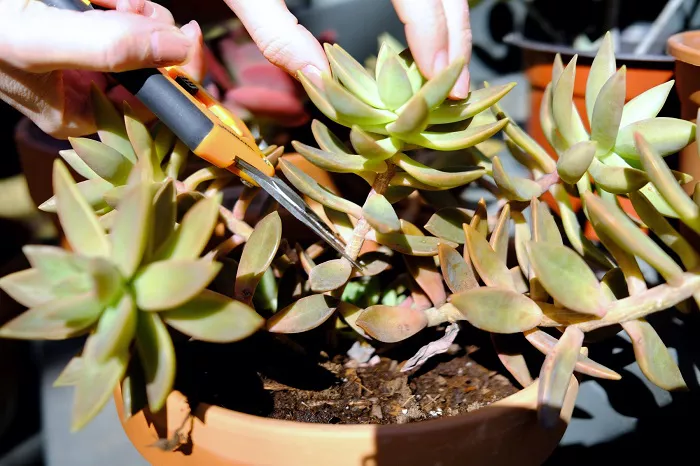Succulents are beloved for their unique shapes, low maintenance, and ability to thrive in various conditions. However, when they grow too tall or leggy, they may lose their charm and health. Cutting long succulents is a simple yet essential skill to keep them thriving and looking their best. In this guide, we’ll walk you through the process step by step, from understanding why succulents grow long to how to propagate the cuttings. Whether you’re a beginner or an experienced gardener, this article will help you master the art of pruning and propagating succulents.
Why Do Succulents Grow Long?
Succulents often grow tall and leggy due to a lack of sunlight. When they don’t receive enough light, they stretch out in search of it, a process called etiolation. This results in long stems with widely spaced leaves, making the plant look less compact and healthy. Overwatering or poor soil drainage can also contribute to weak, elongated growth. Understanding the cause of long succulents is the first step to addressing the issue and ensuring your plants stay vibrant and robust.
Tools You’ll Need for Cutting Succulents
Before you start, gather the right tools to ensure a clean and successful cut. Here’s what you’ll need:
Sharp Scissors or Pruning Shears: Clean, sharp tools prevent damage to the plant and reduce the risk of infection.
Rubbing Alcohol: Use this to sterilize your tools before and after cutting.
Gloves: Some succulents have sap that can irritate the skin, so gloves are a good precaution.
A Clean Workspace: Choose a flat, clean surface to work on.
Well-Draining Soil and Pots: If you plan to propagate the cuttings, have these ready.
Step-By-Step Guide To Cutting Long Succulents
1. Assess the Plant
Start by examining your succulent. Identify the areas where the stems are too long or leggy. Look for healthy leaves and nodes, as these will be crucial for propagation.
2. Sterilize Your Tools
Dip your scissors or pruning shears in rubbing alcohol to sterilize them. This step prevents the spread of diseases or pests to your plant.
3. Make the Cut
Cut the stem about 1-2 inches above the soil line or just below a leaf node. Make sure the cut is clean and straight. If the succulent has multiple stems, you can cut them individually.
4. Let the Cutting Dry
Place the cuttings in a dry, shaded area for 2-3 days to allow the cut ends to callous over. This step is crucial to prevent rot when you plant them.
5. Plant the Cuttings
Once the cuttings have calloused, plant them in well-draining soil. Water lightly and place them in a bright, indirect light location.
Propagating Succulent Cuttings
One of the best things about cutting long succulents is that you can propagate the cuttings to grow new plants. Here’s how:
Leaf Propagation: Gently twist off healthy leaves from the stem. Let them dry for a few days, then place them on top of soil. Mist occasionally until roots form.
Stem Propagation: Use the stem cuttings you’ve already prepared. Plant them in soil and wait for new roots to develop.
Offshoot Propagation: If your succulent has produced offshoots (pups), carefully separate them from the parent plant and plant them individually.
Caring for Your Pruned Succulents
After cutting and propagating, proper care is essential to ensure your succulents thrive.
Light: Place your succulents in a spot with bright, indirect sunlight. Avoid direct sun, which can scorch the leaves.
Watering: Water sparingly, allowing the soil to dry out completely between waterings. Overwatering is the most common cause of succulent problems.
Soil: Use a well-draining soil mix designed for succulents and cacti.
Fertilizing: Feed your succulents with a diluted, balanced fertilizer during the growing season (spring and summer).
Common Mistakes to Avoid
Cutting Too Much at Once: Avoid removing more than one-third of the plant at a time, as this can stress it.
Using Dirty Tools: Always sterilize your tools to prevent infections.
Overwatering New Cuttings: Newly planted cuttings are prone to rot if overwatered. Wait until roots have formed before watering regularly.
Ignoring Light Needs: Ensure your succulents get enough light to prevent them from growing long again.
Benefits of Cutting Long Succulents
Pruning long succulents offers several benefits:
Improved Appearance: Cutting leggy stems restores the plant’s compact, attractive shape.
Healthier Growth: Pruning encourages new, healthy growth and prevents disease.
More Plants: Propagating cuttings allows you to grow more succulents for free.
Prevents Overcrowding: Regular pruning keeps your succulent collection manageable and thriving.
Frequently Asked Questions
1. Can I cut a succulent and replant it?
Yes, you can cut a succulent and replant it. Just make sure to let the cutting callous over before planting.
2. How often should I prune my succulents?
Prune your succulents as needed when they become leggy or overgrown. This could be once or twice a year, depending on the plant’s growth rate.
3. Will cutting my succulent kill it?
No, cutting your succulent won’t kill it. In fact, it can promote healthier growth and give you new plants through propagation.
4. Can I propagate all types of succulents?
Most succulents can be propagated, but some varieties are easier than others. Research your specific succulent type for the best results.
Conclusion
Cutting long succulents is a simple and rewarding process that keeps your plants healthy and beautiful. By following the steps outlined in this guide, you can prune your succulents with confidence and even grow new plants from the cuttings. Remember to use clean tools, provide proper care, and avoid common mistakes to ensure success. With a little practice, you’ll become a pro at managing your succulent collection and enjoying their unique beauty for years to come. Happy gardening!


